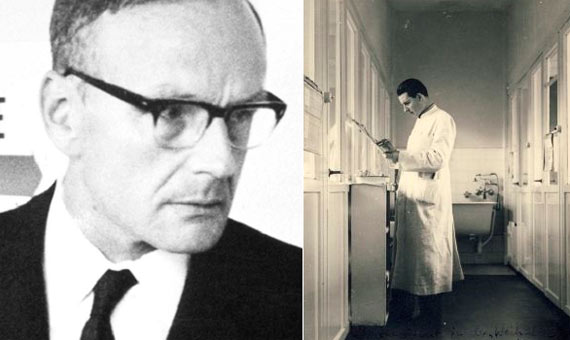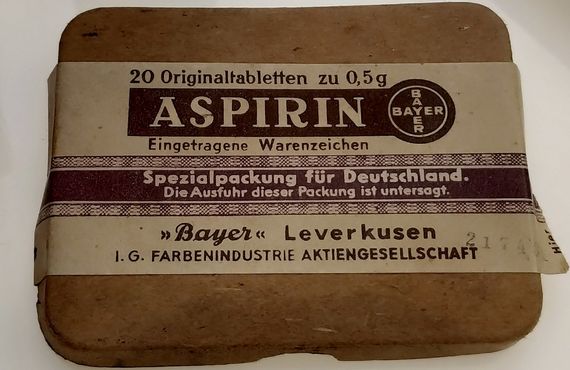In the regulated world of pharmaceutical drugs, the investment of time and money needed to bring a new medicine to market has soared, taking around ten years and costing an average of almost 1.2 billion euros. This limitation has led researchers to think of alternative methods to find new medical uses for existing drugs, known as repurposing or repositioning. One such avenue is to check for adverse or secondary effects.
For example, the inhaler compound Ventolin (salbutamol or albuterol), an asthma treatment, has been used in injectable form to prevent premature births, although safer drugs are now preferred. Arsenic, the famous poison, is now used as a treatment for leukaemia. We take a look at cases where an effect found by accident has given the drug more impact than its original purpose.
THE SERENDIPITY OF ONE OF THE WORLD’S BEST-SELLING DRUGS
Sildenafil (Viagra):
The recycling of existing drugs for new uses even includes one of the best-selling drugs of all time. Viagra was not originally conceived as a treatment for erectile dysfunction that would earn billions dollars a year in its first two years on the market, but rather as a drug to treat hypertension. In the mid-1990s in the UK, the pharmaceutical company Pfizer began clinical trials to test the efficacy of sildenafil for angina pectoris and pulmonary hypertension. They were looking for a drug that could relax blood vessels, as angina narrowed the vessels that carry blood to the heart.

The results were disappointing. The laboratory was about to abandon the trials when some volunteers returned to report an unusual side effect: the drug helped them have stronger erections. In 1996, Pfizer decided to patent the drug. Prior to its commercial launch in 1998, there was no oral treatment for erectile dysfunction, which had to be treated by injection or with a prosthetic implant. Thus, thanks to a failed treatment for angina pectoris, one of the most prescribed drugs in the world was discovered.
FROM SHUNNED DRUG TO CANCER TREATMENT
Thalidomide
While Viagra is an example of the commercial potential of repurposing, the case of thalidomide provides an even more radical example. The first and brutal side-effect found with this drug led to disaster, yet further research found other uses for it as a treatment for cancer or leprosy. Thalidomide was marketed by the German laboratory Chemie Grünenthal between 1957 and 1963 as a sedative to relieve anxiety, insomnia, nausea and vomiting in pregnant women. It was sold in almost 50 countries and only in the United States was its distribution prevented when a reviewer for the U.S. Food and Drug Administration, Frances Oldham Kelsey, distrusted the information provided by the company, which did not include results on its safety, and six times refused to give it the green light until more data were provided.

In 1962, paediatricians Claus Knapp and Widukind Lenz published a paper warning of the link between thalidomide ingestion during early pregnancy and severe malformations in foetuses. Babies that survived were born without legs and arms and sometimes also with internal organ problems. It is estimated that around 10,000 children were affected by the drug. This case tightened the safety controls needed to bring a drug to market and it is possible that, in part, the development of new drugs is so difficult today because of what happened then. In the U.S., Oldham Kelsey received the President’s Award for Distinguished Federal Civilian Service, the highest government award for a civilian, from President John F. Kennedy in 1962 for blocking the American approval of thalidomide.
However, half a century later, thalidomide is being used to combat a variety of diseases, from cancer to leprosy. In 1979, it began to be used for the treatment of Behçet’s syndrome (a chronic rheumatic disease). Its anti-angiogenic properties—preventing the formation of new blood vessels, such as those that feed tumours—have also been described, and favourable results have been found in multiple myeloma. All this, of course, is with new safeguards to prevent pregnant women from ever taking the drug again.
SURPRISING ANTI-BALDNESS LOTION
Minoxidil (Rogaine)
The search for treatments for hair loss dates back at least to ancient Egypt, 3,500 years ago. In the time of Hippocrates, one of the fathers of medicine, a recommended formula to treat hair loss in women included pigeon droppings. Since then, there has been no end to the appearance of both home and scientific remedies. Some of them have even turned up by chance, an example of which is Minoxidil, marketed as Rogaine for treating baldness.
Minoxidil is a vasodilator that was originally used as a treatment for hypertension under the name Loniten. During clinical trials, it was discovered that some patients taking the drug had increased body hair, both on the scalp and other areas of the body. Doctors labelled this condition hypertrichosis. Researchers at the pharmaceutical company Upjohn took this side effect and developed a lotion to apply directly to the scalp to combat alopecia (hair loss). In 1988, Rogaine began to be marketed separately.
THE SAME DRUG FOR THE PROSTATE AND HAIR LOSS
Finasteride (Propecia, Proscar)
Although nowadays finasteride is often associated with treatments for baldness, it was originally marketed as a drug for benign prostatic hyperplasia (also called prostate gland enlargement), under the brand name Proscar. In 1992, the US drug agency approved its use for this purpose and it was not until six years later that the drug was repurposed, under the brand name Propecia, as a treatment for male pattern hair loss. Researchers found that a lower dose of finasteride (from 5 mg in Proscar to 1 mg in Propecia) could move it from a medical use to a cosmetic one.

At that time, there were not many oral treatments, since the majority—like Minoxidil—were lotions and shampoos. Propecia soon became the new star drug and allowed Merck, the pharmaceutical company that manufactured both drugs, to earn a return on its original investment in Proscar, which had never achieved the hoped-for success. In 2017, the personal doctor of the then newly-elected US president Donald Trump revealed to the media that he was taking finasteride, which gave the drug a boost in popularity due to the many comments about the Republican politician’s hair style.
THE ANTIVIRAL THAT WORKS AGAINST SEVERAL TYPES OF CANCER
Gemcitabine (Gemzar)
Gemcitabine started out as a potential hepatitis E antiviral and was later repositioned as a cancer treatment. The drug was synthesised in an Eli Lilly pharmaceutical laboratory in the early 1980s. Ten years later, pre-clinical laboratory trials showed that it could kill leukaemia cells in vitro. In 1995, Britain became the first country in which it was marketed.
Gemcitabine is currently used as a chemotherapy agent for the treatment of several types of cancer, including lung, pancreatic, bladder, breast, ovarian and testicular cancers. It is also being investigated for use in treating other tumours such as oesophageal cancer and lymphomas.
WHEN AIDS ARRIVED, TREATMENT WAS ALREADY AVAILABLE
Zidovudine or AZT (Retrovir)
For most of the 1980s AIDS was a death sentence, as the newly discovered HIV virus was lethal in almost 100% of cases. It was not until 1987 that the first treatment capable of turning AIDS into a chronic disease, zidovudine or azidothymidine (AZT), was approved and lives began to be saved. But once again, this drug was not the product of research aimed at creating a treatment for a new disease, but a successful example of repurposing.
In the 1960s, various compounds were being investigated to inhibit the synthesis of nucleic acids: DNA and RNA. Since both viruses and cancers need to replicate their genetic material to reproduce, these drugs had potential uses as treatments for cancer and infectious diseases. One such compound studied was AZT, created in 1964 by Jerome Horwitz at the Karmanos Cancer Institute in Detroit.
AZT was initially discarded when it was observed to be useless against cancer in mice. In 1974, the drug was found to work against the murine leukaemia retrovirus, but this attracted little interest, as human retroviruses were not yet known. Everything changed with the advent of AIDS. In 1985, AZT was one of the compounds tested against the first human retrovirus. The excellent laboratory results prompted a clinical trial that eventually led to the drug’s approval just 25 months after the first in vitro observations. Today AZT continues to be used against AIDS in combination with other antiretrovirals.
NEW USES FOR THE OLDEST DRUG
Acetylsalicylic acid (aspirin)
It cannot be said that aspirin’s popularity has necessitated uses other than its original one. But the emergence of new compounds with similar properties caused it to fall into decline, until the discovery of new therapeutic uses has made it almost a cure-all for medicine.

The origins of aspirin date back almost 4,000 years. In Sumer and ancient Egypt, willow bark (genus Salix) was used to relieve pain. Based on this traditional knowledge, in 1763 Edward Stone investigated its use against fever, and in 1828 Johann Buchner extracted an active ingredient, salicin, from the bark. From this he obtained salicylic acid, which in 1853 Charles Frédéric Gerhardt transformed into acetylsalicylic acid. In 1897, the Bayer company began research into its properties, and by the turn of the century aspirin was born. The rest, as they say, is history.
However, with the discovery of paracetamol and ibuprofen in the mid-20th century, aspirin began to lose popularity. It was not until the 1960s to 1980s that its anticoagulant capacity was discovered. It is now commonly prescribed to prevent cardiovascular risk in susceptible individuals, but has also been shown to reduce the incidence and mortality of oesophageal, gastric and colorectal cancers, and possibly also breast, lung and prostate cancers. It is also used in the treatment of rheumatic fever, rheumatoid arthritis, pericarditis and Kasawaki disease in children. Its possible use in certain mental disorders has been studied, although the evidence is not yet conclusive.
Updated by Javier Yanes
original by Beatriz Guillén
Comments on this publication